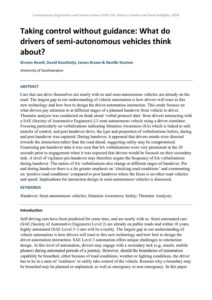| Document | Author Kirsten Revell, David Keszthelyi, James Brown & Neville Stanton |
| Abstract Cars that can drive themselves are nearly with us and semi-autonomous vehicles are already on the road. The largest gap in our understanding of vehicle automation is how drivers will react to this new technology and how best to design the driver-automation interaction. This study focuses on what drivers pay attention to at different stages of a planned handover from vehicle to driver. Thematic analysis was conducted on think aloud ‘verbal protocol data’ from drivers interacting with a SAE (Society of Automotive Engineers) L3 semi-autonomous vehicle using a driver simulator. Focusing particularly on verbalisations indicating Situation Awareness (SA) which is linked to safe transfer of control, and post handover drive, the type and proportion of verbalisations before, during and post handover was captured. During handover, it appeared that drivers minds were directed towards the interaction rather than the road ahead, suggesting safety may be compromised. Examining pre-handover data it was seen that SA verbalisations were very prominent in the 20 seconds prior to engagement when it was expected that drivers would be focused on their secondary task. A level of vigilance pre-handover may therefore negate the frequency of SA verbalisations during handover. The nature of SA verbalisations also change at different stages of handover. Pre and during handover there is a far greater emphasis on ‘checking road conditions’ and commenting on ‘positive road conditions’ compared to post handover where the focus is on other road vehicles and speed. Implications for interaction design in semi-autonomous vehicles is discussed. |

